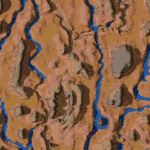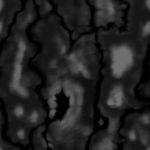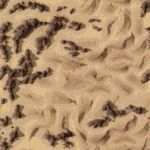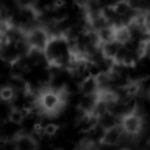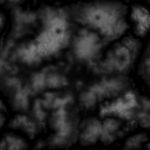Voxel Space:不到20行代码实现地形渲染
姓名:余玥 学号:16010188033
转载自http://blog.csdn.net/dev_csdn/article/details/78651264,有删节。
【嵌牛导读】:1992年,当时的CPU处理速度比现在的要慢1000倍,通过GPU加速当时还未问世,而且CPU也是无法承受的。3D游戏仅在CPU上进行计算,渲染引擎使用单一颜色对多边形进行渲染填充。
【嵌牛鼻子】:游戏/Voxel-Space/渲染算法
【嵌牛提问】:游戏里的地形渲染是如何实现的?
【嵌牛正文】:
Voxel Space
体素空间引擎的Web Demo
追溯历史
让我们把时间拨回到1992年。当时的CPU处理速度比现在的要慢1000倍,通过GPU加速当时还未问世,而且CPU也是无法承受的。3D游戏仅在CPU上进行计算,渲染引擎使用单一颜色对多边形进行渲染填充。
MicroProse于1991年发布的游戏Gunship 2000
同年NovaLogic也发布了游戏科曼奇。
NovaLogic于1992年发布的游戏Comanche
在我看来,当时这种图形出来以后简直叹为观止,它最起码提前了3年。用户可以看到很多的细节,比如山脉,甚至山谷的纹理,这是第一次有一个比较清晰的阴影。当然,它是像素化的,但那时候所有的游戏都是像素化的。
渲染算法
科曼奇使用了一种名为体素空间(Voxel Space)的技术,它和ray casting是基于同一个想法。因此,体素空间引擎是2.5D引擎,它不具有规则的3D引擎提供的所有自由度。。
高度地图和颜色地图
高度地图和颜色图是表示地形最简单的方法。科曼奇使用了1024 * 1024一个字节代表了高度地图,同样使用了1024 * 1024一个字节表示颜色地图,你可以在这个网站上下载。这些地图是周期性:
这样的地图将地形限制为“地图上每个位置一个高度” - 因此像建筑物或树木这样的复杂几何形状不可能表示出来。然而,色彩地图的一大优点是,它已经包含了色彩和阴影。体素空间引擎只需要颜色,在渲染过程中不需要计算光照。
基本算法
对于3D引擎来说,渲染算法非常简单。体素空间引擎负责渲染高度地图和颜色地图,并绘制垂直线。下图演示了这种技术。
清除屏幕。
为了保证遮挡从后面开始并呈现在前面。这被称为画家算法。
确定地图上的线,它对应于与观察者相同的光距离。考虑视场和透视投影(物体在更远的地方)
光栅线是用来匹配屏幕的列数。
从线段对应的二维地图中检索高度和颜色。
执行高度坐标的透视投影。
用透视投影中检索到的高度画一条垂直线。
核心算法以最简单的形式包含了几行代码(python语法):
def Render(p, height, horizon, scale_height, distance, screen_width, screen_height):
# Draw from back to the front (high z coordinate to low z coordinate)
for z in range(distance, 1, -1):
# Find line on map. This calculation corresponds to a field of view of 90°
pleft = Point(-z + p.x, -z + p.y)
pright = Point( z + p.x, -z + p.y)
# segment the line
dx = (pright.x - pleft.x) / screen_width
# Raster line and draw a vertical line for each segment
for i in range(0, screen_width):
height_on_screen = (height - heightmap[pleft.x, pleft.y]) / z * scale_height. + horizon
DrawVerticalLine(i, height_on_screen, screen_height, colormap[pleft.x, pleft.y])
p1eft.x += dx
# Call the render function with the camera parameters:
# position, height, horizon line position,
# scaling factor for the height, the largest distance,
# screen width and the screen height parameter
Render( Point(0, 0), 50, 120, 120, 300, 800, 600 )
添加旋转
按照上面的算法我们只能看到北面。不同的角度需要多行代码来旋转坐标。
def Render(p, phi, height, horizon, scale_height, distance, screen_width, screen_height):
# precalculate viewing angle parameters
var sinphi = math.sin(phi);
var cosphi = math.cos(phi);
# Draw from back to the front (high z coordinate to low z coordinate)
for z in range(distance, 1, -1):
# Find line on map. This calculation corresponds to a field of view of 90°
pleft = Point(
(-cosphi*z - sinphi*z) + p.x,
( sinphi*z - cosphi*z) + p.y)
pright = Point(
( cosphi*z - sinphi*z) + p.x,
(-sinphi*z - cosphi*z) + p.y)
# segment the line
dx = (pright.x - pleft.x) / screen_width
dy = (pright.y - pleft.y) / screen_width
# Raster line and draw a vertical line for each segment
for i in range(0, screen_width):
height_on_screen = (height - heightmap[pleft.x, pleft.y]) / z * scale_height. + horizon
DrawVerticalLine(i, height_on_screen, screen_height, colormap[pleft.x, pleft.y])
p1eft.x += dx
p1eft.y += dy
# Call the render function with the camera parameters:
# position, viewing angle, height, horizon line position,
# scaling factor for the height, the largest distance,
# screen width and the screen height parameter
Render( Point(0, 0), 0, 50, 120, 120, 300, 800, 600 )
更多的性能说明
当然,要想达到更高的性能,还有很多小技巧可以使用。
与从后面到前面绘制相比,从前面到后面进行绘制会更好。优点之一就是我们不必每次都因为遮挡而需要在屏幕的底部画线。但是,为了保证遮挡,我们需要一个额外的Y缓冲区。对于每一列来说,相当于y的最高位置已经存储了。因为我们是按照从前面到后面这个顺序进行绘制的,那么下一行的可见部分只能大于先前绘制的最高行。
详细的渲染程度。前面的细节渲染多一点,远处的细节渲染的少一点。
def Render(p, phi, height, horizon, scale_height, distance, screen_width, screen_height):
# precalculate viewing angle parameters
var sinphi = math.sin(phi);
var cosphi = math.cos(phi);
# initialize visibility array. Y position for each column on screen
ybuffer = np.zeros(screen_width)
for i in range(0, screen_width):
ybuffer[i] = screen_height
# Draw from front to the back (low z coordinate to high z coordinate)
dz = 1.
z = 1.
while z < distance
# Find line on map. This calculation corresponds to a field of view of 90°
pleft = Point(
(-cosphi*z - sinphi*z) + p.x,
( sinphi*z - cosphi*z) + p.y)
pright = Point(
( cosphi*z - sinphi*z) + p.x,
(-sinphi*z - cosphi*z) + p.y)
# segment the line
dx = (pright.x - pleft.x) / screen_width
dy = (pright.y - pleft.y) / screen_width
# Raster line and draw a vertical line for each segment
for i in range(0, screen_width):
height_on_screen = (height - heightmap[pleft.x, pleft.y]) / z * scale_height. + horizon
DrawVerticalLine(i, height_on_screen, ybuffer[i], colormap[pleft.x, pleft.y])
if height_on_screen < ybuffer[i]:
ybuffer[i] = heightonscreen
p1eft.x += dx
p1eft.y += dy
# Go to next line and increase step size when you are far away
z += dz
dz += 0.2
# Call the render function with the camera parameters:
# position, viewing angle, height, horizon line position,
# scaling factor for the height, the largest distance,
# screen width and the screen height parameter
Render( Point(0, 0), 0, 50, 120, 120, 300, 800, 600 )
地图
颜色,高度
颜色,高度
颜色,高度
颜色,高度
颜色,高度
颜色,高度
颜色,高度
颜色,高度
颜色,高度
颜色,高度
颜色,高度
颜色,高度
颜色,高度
颜色,高度
颜色,高度
颜色,高度
颜色,高度
颜色,高度
颜色,高度
颜色,高度
颜色,高度
颜色,高度
颜色,高度
颜色,高度
颜色,高度
颜色,高度





